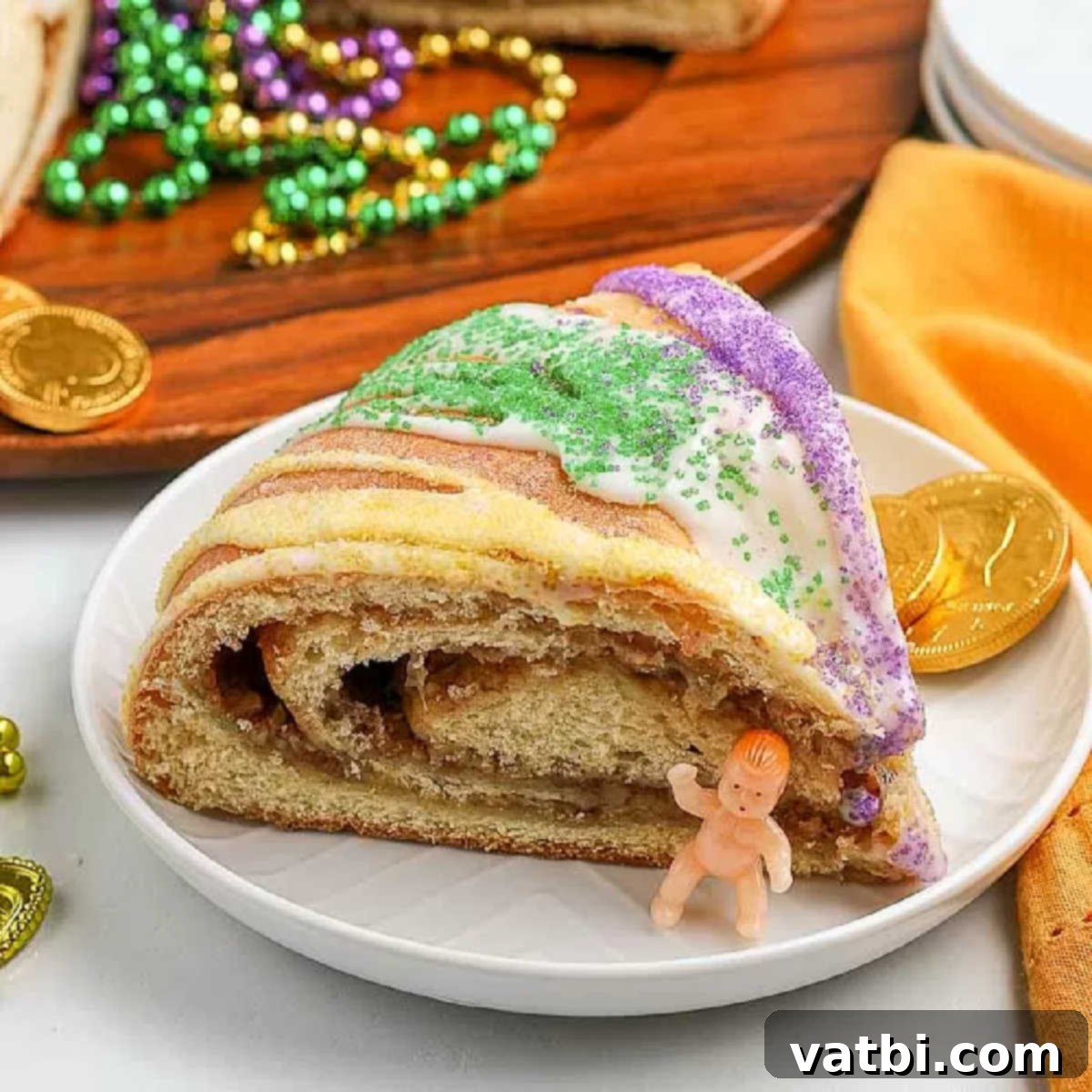Authentic Mardi Gras King Cake Recipe: Your Ultimate Guide to a Festive Homemade Tradition
Prepare to infuse your celebrations with the vibrant spirit of Carnival! This comprehensive guide will teach you how to bake a traditional, incredibly delicious, and visually stunning Mardi Gras King Cake recipe. Perfect for marking the joyous occasion, this easy-to-follow king cake recipe is not only a treat for the taste buds but also a feast for the eyes, adorned with its signature festive purple, green, and gold colors. Forget the bakery; you can easily master this delightful New Orleans classic right in your own kitchen.
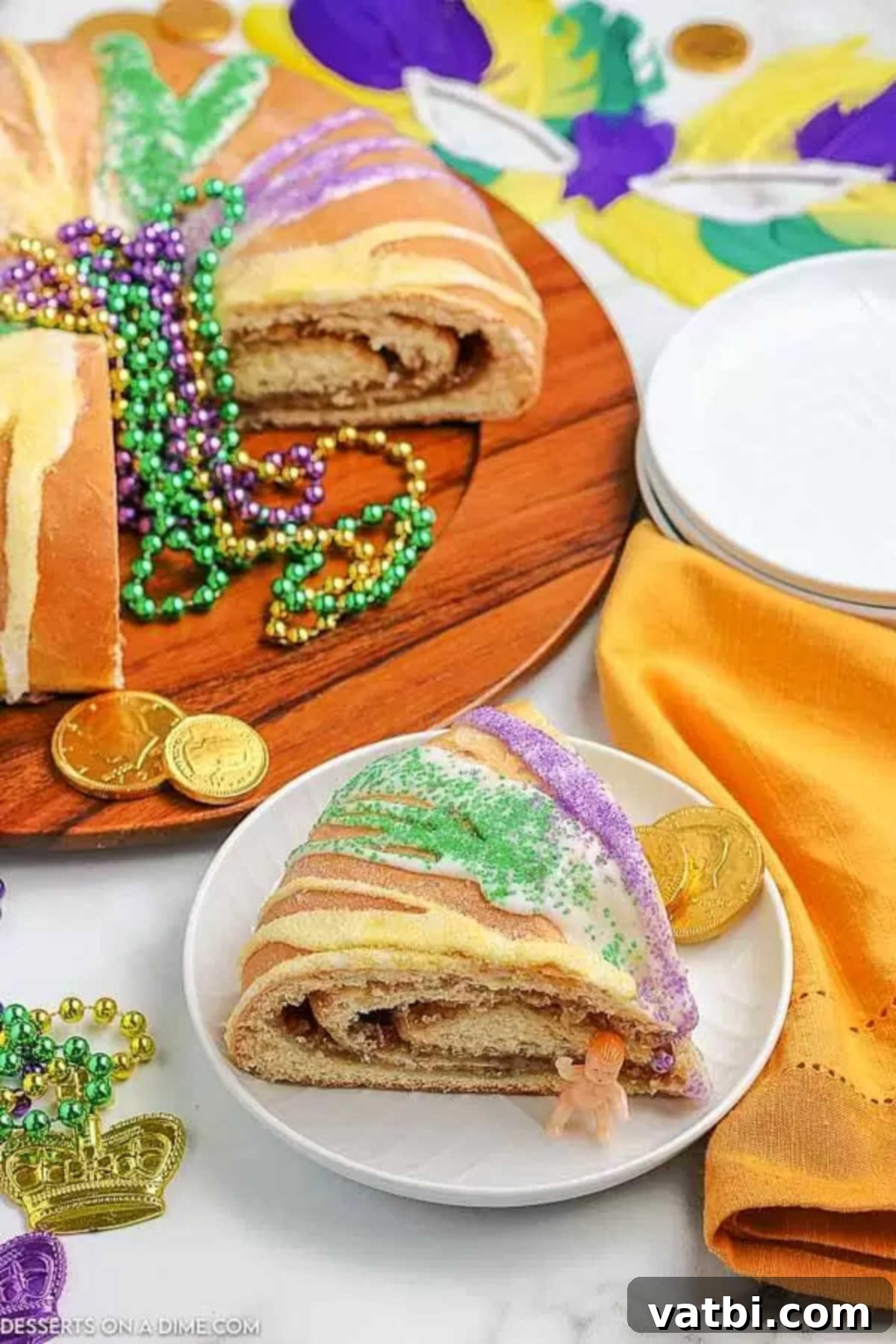
If you’re among those who eagerly anticipate and celebrate Mardi Gras, then mastering this King Cake Mardi Gras recipe is an absolute must. This classic cake recipe is surprisingly easy to bake, using simple, readily available ingredients, and it truly comes to life with the fun, iconic green, purple, and gold colors that symbolize the holiday.
This detailed guide will walk you through every step of making this delightful Mardi Gras cake from scratch. The finished pastry boasts a wonderfully soft and slightly sweet texture, often compared to that of freshly baked Cinnamon Rolls, making it an irresistible treat. A traditional King Cake is enjoyed throughout the entire Carnival season, which traditionally begins on January 6th (Twelfth Night or Epiphany) and culminates on Fat Tuesday (Mardi Gras), the day before Ash Wednesday.
However, the joy of baking and celebrating knows no bounds! Many, including ourselves, choose to enjoy this delicious cake beyond the official Carnival season. Simply by altering the decorative colors, you can transform it into a festive centerpiece for almost any holiday or special occasion throughout the year. Even if you don’t reside in the heart of New Orleans, you can bring a piece of its unique culinary tradition and festive spirit into your home. There’s no need to visit a specialty bakery when you can easily create this delicious, authentic King Cake in your own kitchen.
Table of Contents
- What is King Cake?
- Ingredients for Your King Cake
- Flavorful Filling Ingredients
- Sweet Glaze Ingredients
- Festive Decoration Elements
- How to Make a Homemade King Cake: Step-by-Step
- How to Prepare the Perfect Glaze
- Frequently Asked Questions About King Cake
- Expert King Cake Recipe Tips for Success
- More Delightful Easy Cake Recipes
What is King Cake? Understanding the Tradition and Symbolism
The King Cake is much more than just a dessert; it’s a deeply rooted seasonal treat synonymous with New Orleans and the broader celebration of Carnival. At its core, it’s a decadent pastry cake, typically braided or shaped into a large oval, and lavishly decorated with a generous amount of colorful icing, sprinkles, and often, sugar in the signature Mardi Gras colors. Its texture beautifully bridges the gap between a rich coffee cake and a sweet pastry, all tied together with a delicious glaze drizzled over the top.
Historically, this cake is served from King’s Day (January 6th, the Epiphany) through Fat Tuesday, marking the arrival of the Three Wise Men who brought gifts to baby Jesus. It’s a grand tradition that heralds the beginning of the Carnival season. A distinctive feature of the King Cake is its circular or oval shape, symbolizing unity and endless celebration. Traditionally, a small plastic baby (representing baby Jesus) is hidden inside the cake.
The vibrant icing colors are not merely decorative; they carry profound symbolism:
- Purple: Represents Justice
- Green: Symbolizes Faith
- Gold: Stands for Power
These colors are integral to the Mardi Gras festivities and are proudly displayed on every authentic King Cake. While many King Cakes feature a simple cinnamon-sugar swirl, traditional varieties often include rich fillings like cream cheese, fruit, or praline. The person who finds the hidden baby in their slice is traditionally said to receive good luck and is designated as the “King” or “Queen” of the next Mardi Gras gathering, often taking on the responsibility of hosting the following year’s celebration or providing the next King Cake.
Gathering Your Ingredients for a Perfect King Cake
Crafting the perfect Mardi Gras King Cake starts with selecting quality ingredients. Each component plays a vital role in achieving that wonderfully soft texture, rich flavor, and festive appearance. Below is a detailed list of what you’ll need for the dough, the flavorful filling, the sweet glaze, and the iconic decorations. Using fresh ingredients will make a noticeable difference in the final taste and texture of your homemade King Cake.
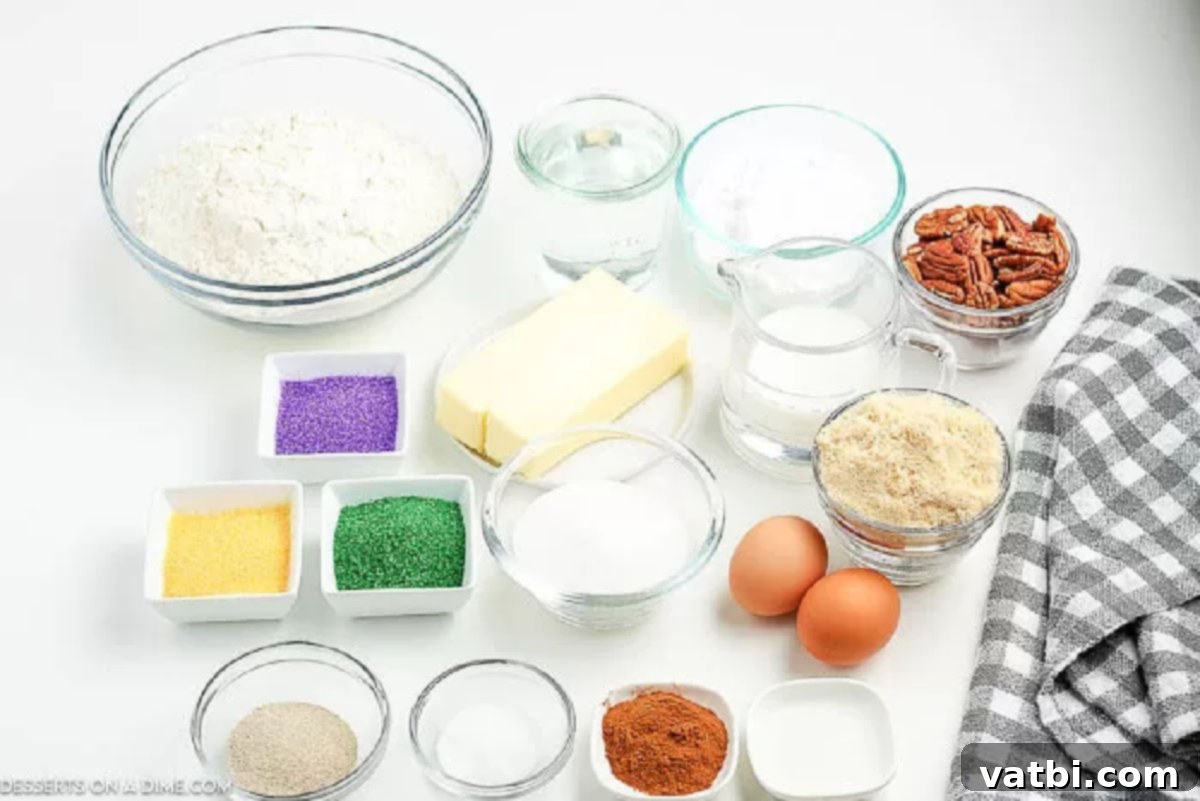
- Active Dry Yeast: Essential for a light and airy dough. Always double-check that your yeast is fresh and within its expiration date for optimal proofing.
- Warm Water: Crucial for activating the yeast. Ensure the water temperature is between 100-110 degrees F (38-43 degrees C); too hot will kill the yeast, too cold won’t activate it.
- Granulated Sugar: Used in both the dough and for activating the yeast. Regular, fine white granulated sugar works best for sweetness and texture.
- All-Purpose Flour: The foundation of your dough. To ensure accurate measurement, spoon the flour into your measuring cup and then level it off with a straight edge.
- Milk: Adds richness and moisture to the dough. Whole milk is preferred for the best flavor and tenderness.
- Large Eggs: Bring structure, richness, and color to the dough. Ensure they are at room temperature for better incorporation into the mixture.
- Unsalted Butter: Provides tenderness and flavor to the dough. Make sure it’s softened to room temperature for easier mixing.
- Salt: Balances the sweetness and enhances the overall flavor of the cake.
Flavorful Filling Ingredients
- Brown Sugar: Creates a deep, molasses-rich sweetness for the filling. You can even try our Homemade Brown Sugar Recipe for an extra touch.
- Ground Cinnamon: The quintessential spice for a traditional King Cake filling, offering warmth and aromatic notes. Adjust the amount to your personal preference if you prefer a stronger cinnamon flavor.
- Pecans: Adds a delightful crunch and nutty flavor to the filling. If you have nut allergies or simply prefer not to include nuts, you can easily omit them.
- Melted Unsalted Butter: Binds the filling ingredients together and adds moisture and richness.
Sweet Glaze Ingredients
- Powdered Sugar (Confectioners’ Sugar): Forms the base of your smooth, luscious glaze. Sift it before mixing to prevent lumps and ensure a perfectly smooth consistency.
- Milk (or water): Used to thin the glaze to the desired drizzling consistency.
- Clear Vanilla Extract: Provides a pure vanilla flavor without altering the white color of the glaze. You can use regular vanilla extract, but be aware it might give your glaze a slightly off-white tint.
Festive Decoration Elements
- Mini Plastic Baby: The iconic symbol hidden within the King Cake. Remember to wash it thoroughly before carefully placing it into the cake.
- Colored Sugar: The final, crucial touch for a Mardi Gras King Cake. Use the traditional colors of purple (justice), green (faith), and gold (power) to sprinkle generously over the glaze.
A comprehensive list of all ingredients with precise measurements is available in the recipe card at the bottom of the page, ensuring you have everything you need for this festive bake.
How to Make a Homemade King Cake: Step-by-Step Guide
Creating a magnificent Mardi Gras King Cake from scratch might seem daunting, but with these clear, step-by-step instructions, you’ll find the process both enjoyable and rewarding. Follow along carefully to achieve a beautifully risen, perfectly flavored, and artfully decorated King Cake ready for your celebration.
- Step 1 – Activate the Yeast: Begin by heating ¼ cup of warm water to a precise temperature of 100-110 degrees F (38-43 degrees C). This temperature is critical for activating the yeast without killing it. Once the water is at the correct temperature, gently sprinkle the active dry yeast and 1 teaspoon of granulated sugar over the water. Stir gently just enough to moisten and coat the yeast granules. Let this mixture sit undisturbed for 5-10 minutes. During this time, the yeast should “proof,” meaning it will become foamy and bubbly, indicating that it’s alive and active. If it doesn’t foam, your yeast might be old, or the water temperature was off, and you’ll need to start this step over.
- Step 2 – Combine Wet and Dry Ingredients: In the bowl of a stand mixer (or a large mixing bowl if mixing by hand), add the remaining ¼ cup granulated sugar, softened butter, warm milk, room temperature eggs, salt, and approximately 2 cups of the all-purpose flour. Pour in the activated yeast mixture.
- Step 3 – Mix the Dough: Using the paddle attachment of your stand mixer, beat the mixture on low speed until all the ingredients are smoothly combined. If you’re mixing by hand, use a sturdy spoon or whisk to achieve a smooth batter. Once smooth, switch to a dough hook attachment for the stand mixer. This makes combining the dough much easier and more efficient.

Step 4. Gradually Add Remaining Flour: Continue mixing on low speed with the dough hook (or kneading by hand), gradually adding the remaining all-purpose flour, a little at a time, until the dough comes together to form a soft ball. The dough should still be slightly sticky to the touch; this is perfectly normal and indicates a tender finished product. Avoid adding too much flour, as this can result in a dry and tough cake.
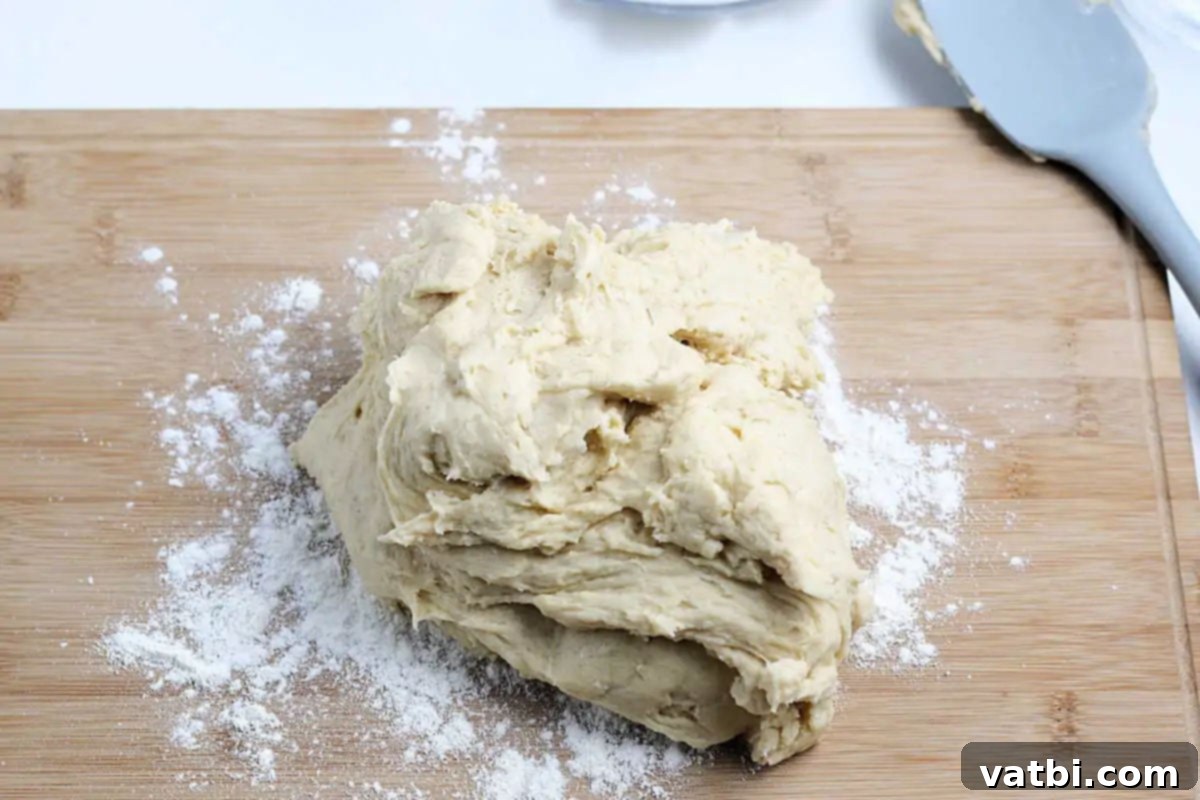
Step 5. Knead the Dough: Lightly sprinkle some flour onto a clean counter or a large cutting board. Turn the soft dough out onto this floured surface. Begin to knead the dough, folding it over on itself, pushing it down, and stretching it. Continue kneading for about 5-7 minutes (longer if by hand) until the dough becomes smooth, elastic, and no longer excessively sticky. This develops the gluten, which is essential for the cake’s structure and rise.
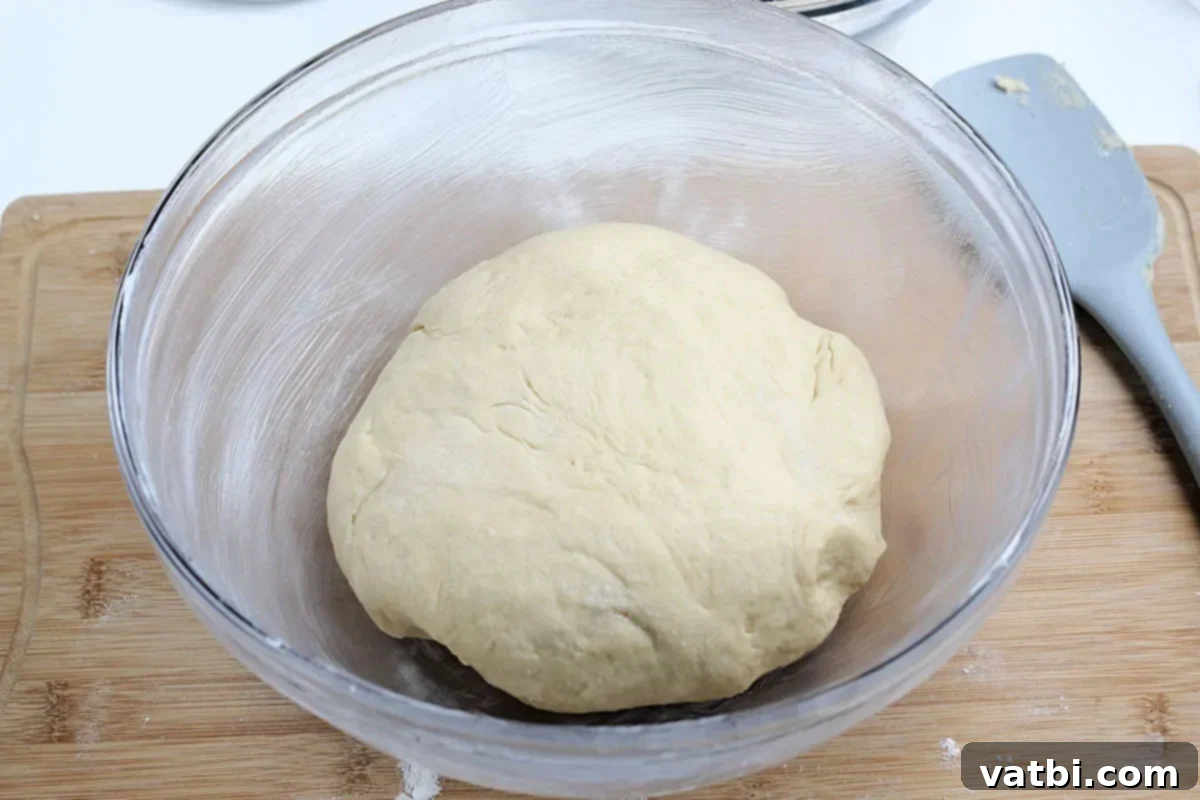
Step 6. First Rise (Proofing): Form the kneaded dough into a neat ball. Lightly grease a large mixing bowl with cooking spray or a small amount of oil. Place the dough ball into the greased bowl, then turn it over once to ensure all sides are lightly coated with oil, preventing it from drying out during the rise. This protective layer is important for maintaining moisture.
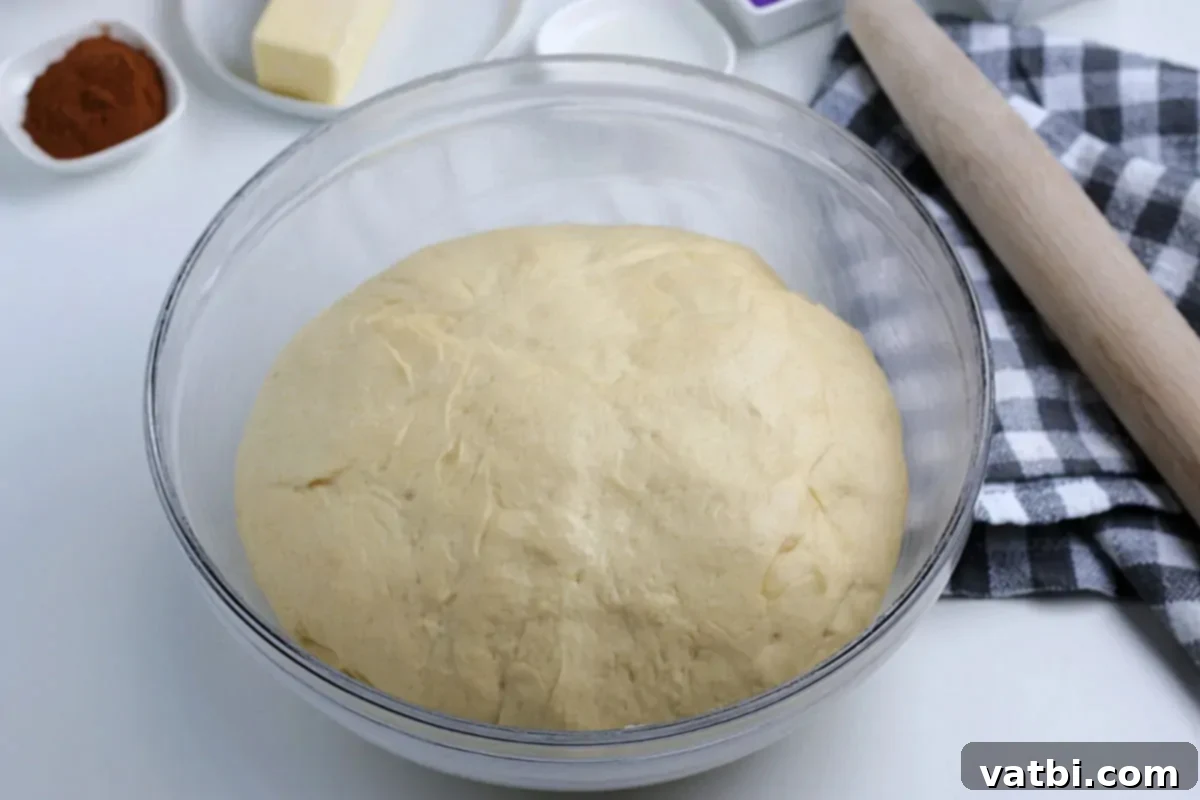
Step 7. Allow the Dough to Rise: Cover the bowl with plastic wrap or a clean kitchen towel. Place the covered bowl in a warm, draft-free spot in your kitchen. Let the dough rise for approximately 45-60 minutes, or until it has visibly doubled in size. The exact time may vary depending on the warmth of your environment.
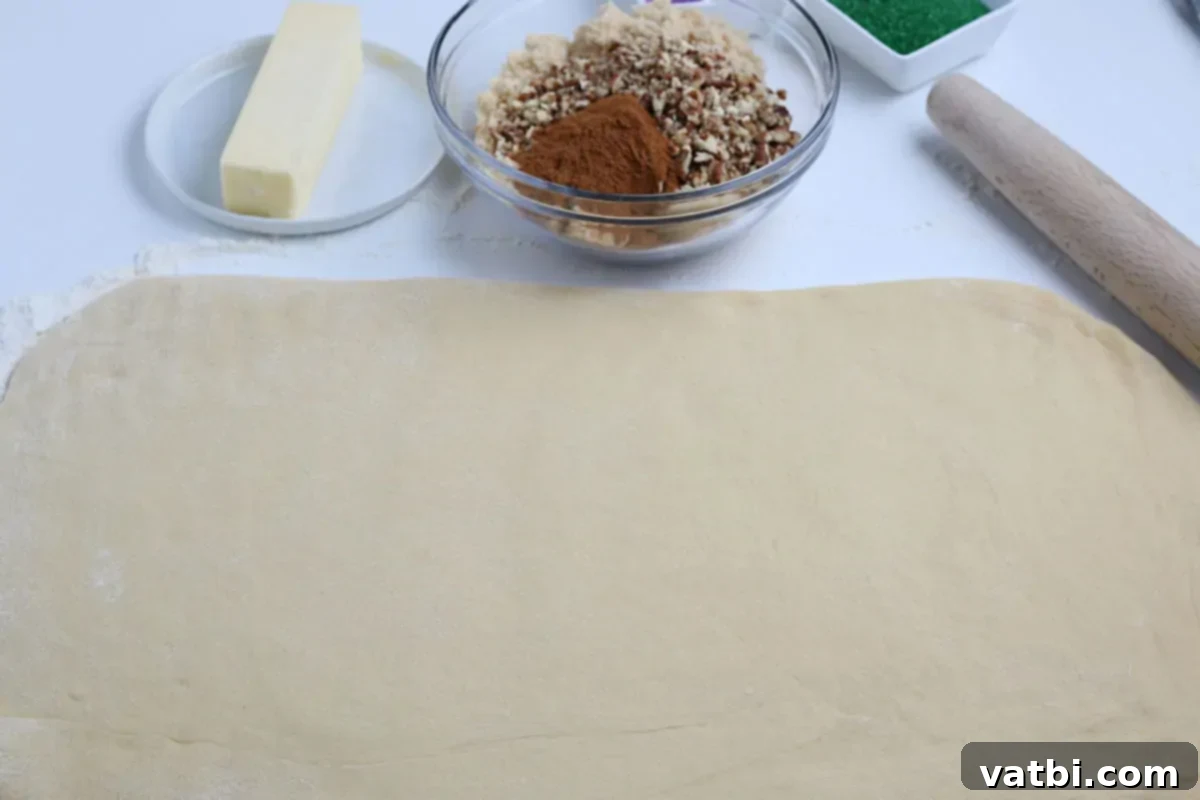
Step 8. Shape the Dough: Once the dough has doubled, gently “punch it down” to release the air. Turn the dough out onto a lightly floured surface. Using a rolling pin, roll the soft dough into a large rectangle, aiming for dimensions of approximately 10×20 inches. Try to keep the thickness as even as possible for uniform baking.
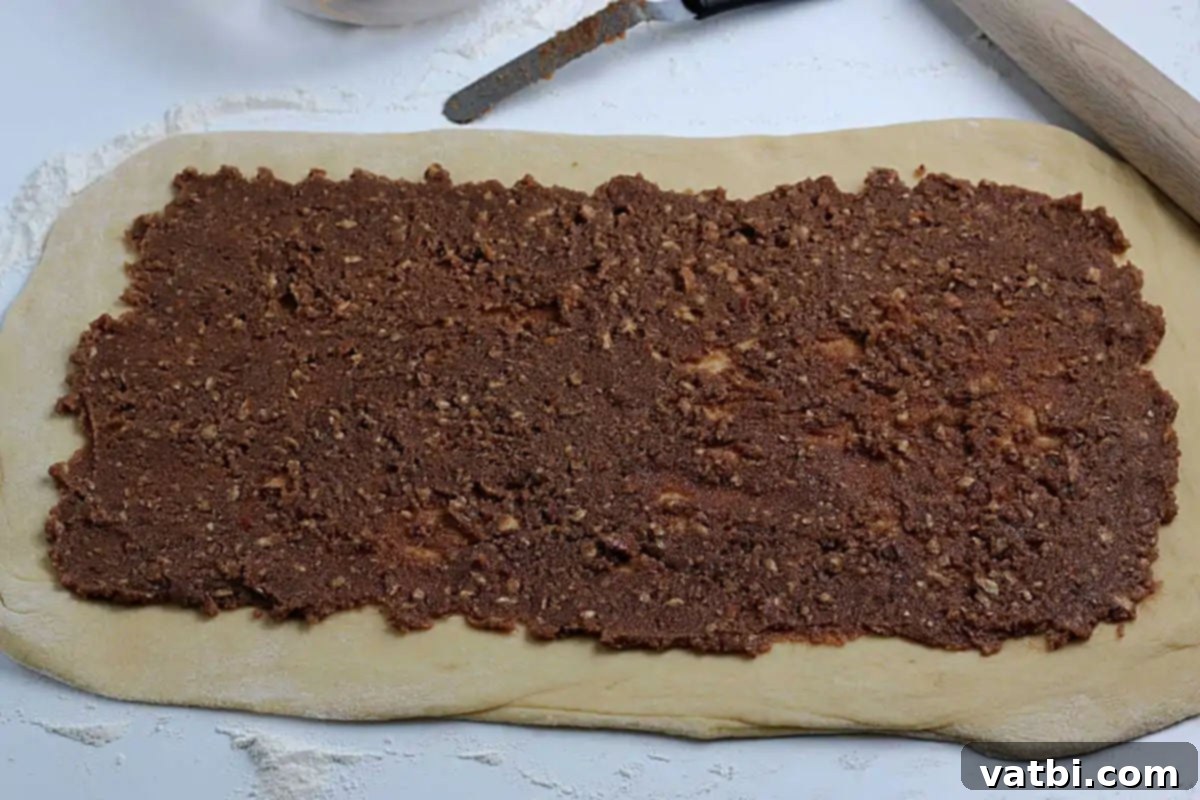
Step 9. Prepare and Add the Filling: In a small bowl, combine the brown sugar, ground cinnamon, and chopped pecans. Set aside. In a separate small saucepan, melt the ½ cup of unsalted butter over medium heat, or simply melt it in the microwave. Pour the melted butter into the cinnamon-sugar-pecan mixture and stir until everything is well combined and forms a moist, crumbly filling. Evenly sprinkle this flavorful filling all over the rolled-out dough rectangle, leaving about a ½-inch border clear around the edges. This border will help seal the cake.

Step 10. Roll and Seal the Dough: Starting from one of the long sides of the rectangle, carefully roll the dough up tightly, just like you would when making a jelly roll cake. Once rolled, pinch the seam firmly along the entire length to seal the dough securely. This prevents the filling from escaping during baking.
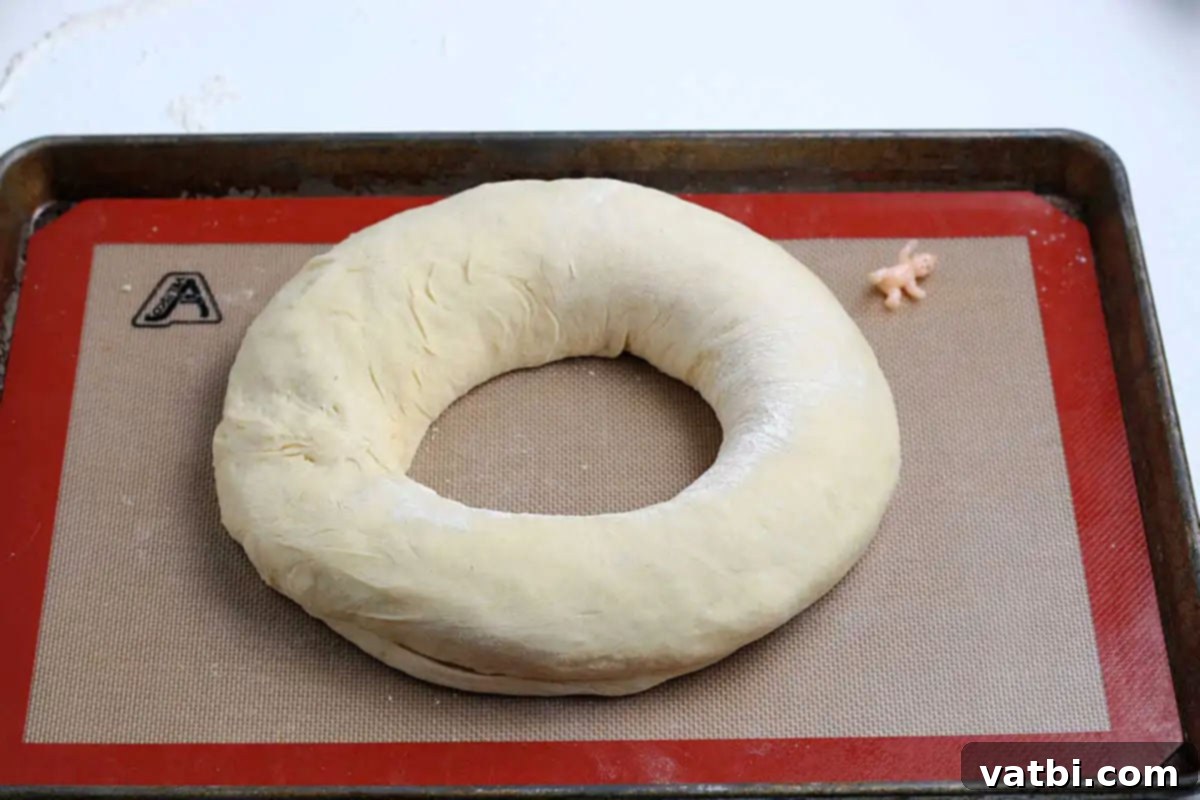
Step 11. Shape, Second Rise, and Bake: Gently move the rolled dough log to a prepared baking sheet lined with parchment paper or a silicone mat. Form the log into a large circle or oval, bringing the two ends together. Firmly pinch these ends to create a continuous ring, ensuring the seam side is down on the baking sheet. Cover the dough ring with plastic wrap or a clean towel and let it rise again in a warm, draft-free spot for another 45-60 minutes, or until it has almost doubled in size once more. About 20 minutes before the second rise is complete, preheat your oven to 350 degrees F (175 degrees C). Once risen, bake the King Cake in the preheated oven for 25-35 minutes, or until it’s beautifully golden brown on top and cooked through. Remove from the oven and let the cake cool completely on a wire rack before glazing.
Don’t forget to discreetly insert the mini plastic baby into the underside of the cake after it has cooled but before glazing. This ensures it’s hidden and won’t melt in the oven.
How to Make the Perfect Festive Glaze
The glaze is the crowning glory of your Mardi Gras King Cake, providing both sweetness and the base for the iconic colorful sugars. Achieving the right consistency is key for a beautiful drizzle.
- Step 1 – Mix Glaze Ingredients: In a medium bowl, combine the sifted powdered sugar, 1 tablespoon of milk, and ½ teaspoon of clear vanilla extract. Whisk vigorously until all ingredients are thoroughly combined and the mixture is smooth. Add additional milk, ¼ teaspoon at a time, if the glaze is too thick, until you reach your desired drizzling consistency. It should be thick enough to cling to the cake but still thin enough to flow smoothly.
- Step 2 – Drizzle and Decorate: Once the King Cake has completely cooled on the wire rack, it’s time to apply the glaze. Using a spoon, generously drizzle the smooth glaze all over the top of the cake, allowing it to gently drip down the sides. While the glaze is still wet, immediately sprinkle with the traditional Mardi Gras colored sugars—purple, green, and gold—in alternating sections or a pattern of your choice. The vibrant sugars will adhere beautifully to the fresh glaze, completing your festive masterpiece.
Frequently Asked Questions About Mardi Gras King Cake
While there are countless delightful variations of King Cake fillings today, a truly traditional King Cake is most commonly flavored with a fragrant cinnamon swirl. This simple yet inviting flavor is complemented by a sweet white glaze and then adorned with the fun and festive colors of green (faith), purple (justice), and gold (power). Some regional variations might feature a plain dough with only the colored sugar as flavor, or incorporate a cream cheese or fruit filling for added richness.
For the absolute best taste and texture, this homemade King Cake is best enjoyed on the very day it is made, when it is at its freshest and softest. However, if you find yourself with leftovers, you can store them on the counter at room temperature for 1 to 2 days, ideally covered tightly to prevent it from drying out. For longer storage, place the King Cake in an airtight container and refrigerate it for up to a week. To revive its freshness after refrigeration, you can gently warm slices in the microwave for a few seconds.
The inclusion of a small plastic baby (or “fève” in French, traditionally a ceramic bean) in the King Cake is a cherished and ancient tradition with roots in European Epiphany celebrations. The baby represents baby Jesus and symbolizes good luck and prosperity for the person who finds it. According to Mardi Gras tradition, the individual whose slice of cake contains the baby is said to receive good fortune and is crowned the “Mardi Gras King” or “Queen” at the party. Furthermore, this person is traditionally responsible for making or buying the King Cake for the following year and often hosts the next Carnival celebration, keeping the festive tradition alive.
Yes, you absolutely can! To prepare ahead, after the first rise (Step 7), gently punch down the dough, form it into a ball, and place it back in the greased bowl. Cover it tightly with plastic wrap and refrigerate overnight or for up to 24 hours. When you’re ready to bake, remove the dough from the fridge and allow it to come to room temperature (about 1-2 hours) before proceeding with Step 8 of rolling out the dough and continuing with the recipe.
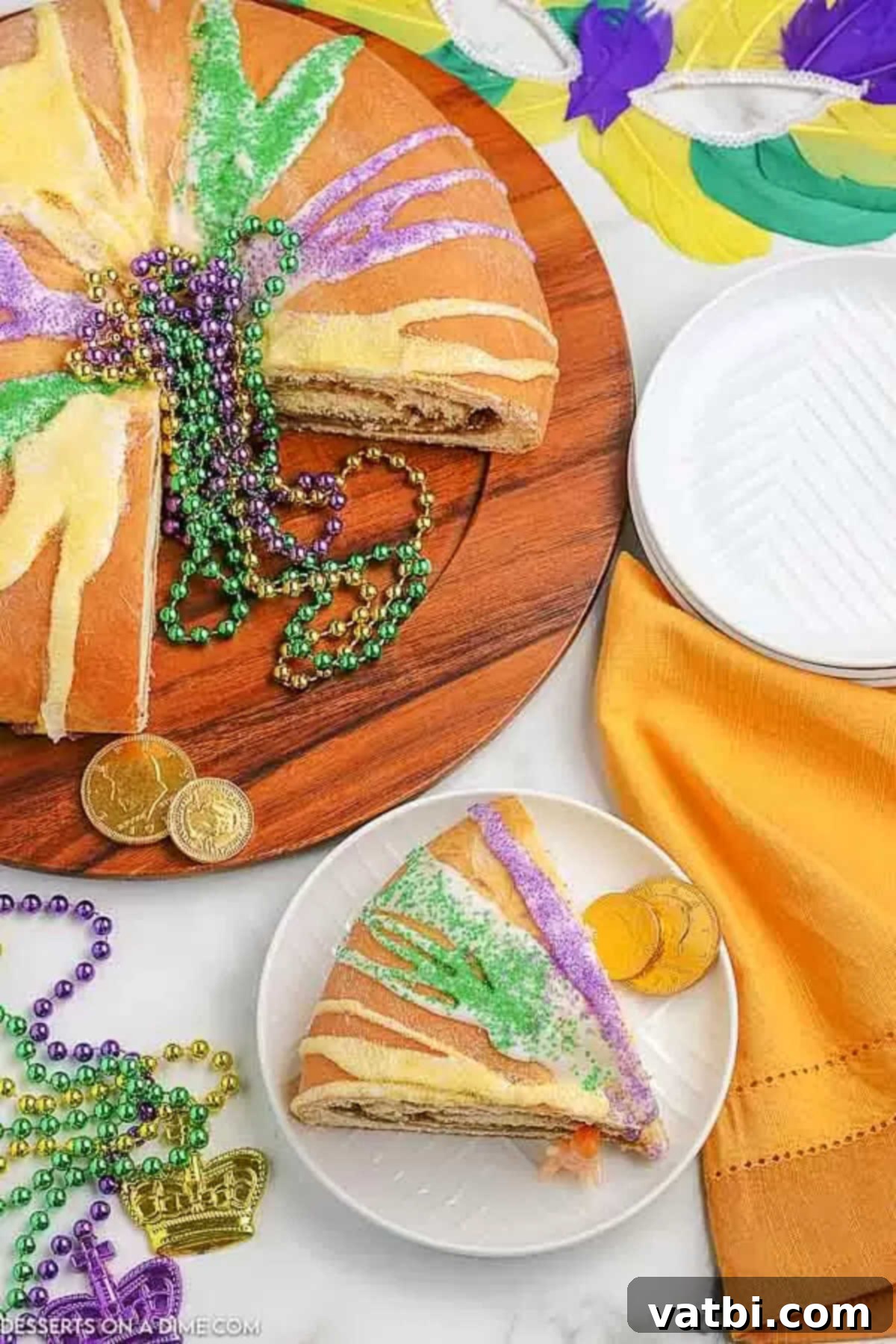
Expert King Cake Recipe Tips for Success
To ensure your homemade Mardi Gras King Cake turns out perfectly every time, keep these valuable tips in mind:
- Make Ahead Option: As mentioned in the FAQs, you can prepare the dough in advance. After the first rise, refrigerate the dough overnight. On baking day, simply allow the dough to come to room temperature for 1-2 hours before continuing with rolling and shaping. This is a great way to spread out the baking process.
- Prepare Your Baking Sheet: Always spray your baking sheet with cooking spray or line it with parchment paper or a silicone baking mat before placing the shaped dough on it. This prevents sticking and ensures easy removal after baking.
- Monitor Cooking Time: Oven temperatures can vary, so the exact cooking time for your King Cake might differ slightly. While the recipe suggests 25-35 minutes, keep a close eye on your cake. It’s done when it’s beautifully golden brown on top and a wooden skewer inserted into the thickest part comes out clean.
- Warm Environment for Rising: Yeast loves warmth! If your kitchen is cool, you can create a warm environment for your dough to rise. Turn your oven on to its lowest setting (or just the light) for a few minutes, then turn it off. Place the covered dough in the slightly warm oven to rise. Just be sure it’s not too hot!
- Don’t Over-Flour: While a lightly floured surface is needed for kneading and rolling, avoid adding excessive flour to your dough. Too much flour can make the cake dense and dry. A slightly sticky dough is preferable for a tender crumb.
- Even Rolling: When rolling out your dough rectangle, strive for even thickness. This ensures that the cake bakes uniformly and creates consistent swirls of filling throughout.
- Cool Completely Before Glazing: It’s essential that the King Cake is completely cool before you apply the glaze. If the cake is still warm, the glaze will simply melt and run off, resulting in a soggy mess rather than a beautiful, set topping.
- Get Creative with Decorations: While traditional purple, green, and gold sugars are classic for Mardi Gras, don’t hesitate to get creative! You can use other colored sugars or sprinkles for different holidays or themed parties.
More Easy Cake Recipes to Delight Your Taste Buds
If you’ve enjoyed baking this festive King Cake, you’re in for a treat with these other incredibly easy and delicious cake recipes. Expand your baking repertoire with these delightful options:
- Irresistible Butterscotch Cake Recipe
- Scrumptious Strawberry Crunch Cake Recipe
- Delightful Banana Bundt Cake Recipe
I’m so excited for you to try this authentic Mardi Gras King Cake Recipe! Your kitchen will be filled with the sweet aroma of tradition and your table with a centerpiece of joy. Please leave a comment and a star rating once you’ve had a chance to bake and enjoy it. Happy baking and Laissez les bons temps rouler!
Pin
Mardi Gras King Cake Recipe
Ingredients
- 1 packet (.25 ounce) active dry yeast, ensuring it’s fresh for optimal rising.
- ¼ cup warm water (100-110 degrees F / 38-43 degrees C, crucial for activating yeast).
- 1 teaspoon granulated sugar (for yeast activation).
- 3 ½-4 cups all-purpose flour (divided, spooned and leveled for accuracy).
- ¼ cup granulated sugar (for the dough).
- 1 cup milk (warm, 100-110 degrees F / 38-43 degrees C, preferably whole milk).
- 1 teaspoon salt (to enhance flavor).
- 2 large eggs (at room temperature for better incorporation).
- 6 tablespoons unsalted butter (softened to room temperature for the dough).
- For the Flavorful Filling:
- 1 cup brown sugar (packed).
- 1 tablespoon ground cinnamon (adjust to taste).
- ½ cup pecans (finely chopped, optional).
- ½ cup unsalted butter, melted (1 stick).
- For the Sweet Glaze:
- 1 cup powdered sugar (sifted to prevent lumps).
- 1-2 tablespoons milk (adjust gradually to achieve desired consistency).
- ½ teaspoon clear vanilla extract (for pure white glaze).
- For Festive Decoration:
- mini plastic baby (washed, to hide inside the cake).
- Colored sugar (purple, green, and gold for traditional Mardi Gras colors).
Instructions
-
Heat ¼ cup water to 100-110 degrees F (38-43 degrees C) for optimal yeast activation.
-
Add the active dry yeast packet and 1 teaspoon of granulated sugar to the warm water.
-
Stir gently, just enough to fully coat the yeast granules.
-
Allow the mixture to set and proof for 5-10 minutes, or until it becomes visibly bubbly and foamy, indicating active yeast.
-
In a large mixing bowl (preferably a stand mixer bowl), add the remaining ¼ cup granulated sugar, softened butter, warm milk, room temperature eggs, salt, and 2 cups of the all-purpose flour. Pour in the activated yeast mixture.
-
Beat the mixture (using a paddle attachment or by hand) until it is completely smooth and well combined.
-
Gradually add more all-purpose flour, about ½ cup at a time, continuing to mix until the dough forms a soft ball. It will remain slightly sticky, which is normal for a tender cake.
-
Turn the sticky dough out onto a lightly floured surface. Knead the dough vigorously for 5-7 minutes until it becomes smooth, elastic, and less sticky to the touch.
-
Form the kneaded dough into a smooth ball and place it into a greased bowl. Turn the dough over once to ensure all sides are coated with grease, preventing a dry crust.
-
Cover the bowl with plastic wrap and let the dough rise in a warm, draft-free place for 45-60 minutes, or until it has visibly doubled in size.
-
Gently punch the risen dough down to release the air and turn it onto a lightly floured surface, ready for shaping.
-
Using a rolling pin, roll the dough into a large rectangle, approximately 10×20 inches, aiming for even thickness.
-
For the Filling: In a small bowl, combine the brown sugar, ground cinnamon, and chopped pecans.
-
Melt the ½ cup of unsalted butter and add it to the brown sugar and spice mixture.
-
Stir until all the filling ingredients are well combined and moist.
-
Sprinkle the prepared filling evenly over the rolled-out dough, leaving a ½-inch border clear around all edges.
-
Prepare your baking sheet by lining it with a silicone mat or parchment paper for easy removal.
-
Carefully roll the dough from the long side, jelly-roll style, into a tight cylinder. Pinch the seam firmly along the entire length to seal it securely.
-
Transfer the rolled dough log to the prepared baking sheet. Gently form it into a large circle or oval, pinching the ends together tightly to create a seamless ring. Ensure the pinched seam faces downwards.
-
Cover the shaped dough ring with plastic wrap and let it rise for a second time, for 45-60 minutes, or until the ring has almost doubled in size.
-
About 20 minutes before the second rise is complete, preheat your oven to 350 degrees F (175 degrees C).
-
Bake the King Cake for 25-35 minutes, or until it achieves a beautiful golden brown color and is cooked through.
-
Remove from the oven and transfer the cake to a wire rack to cool completely before glazing.
-
For the Glaze: In a small bowl, whisk together the sifted powdered sugar, 1-2 tablespoons of milk (adjusting for desired consistency), and ½ teaspoon of clear vanilla extract until smooth.
-
Once the cake has completely cooled, spoon and drizzle the glaze generously over the top. Immediately add the colored sugar (purple, green, and gold) for decoration while the glaze is still wet.
-
Don’t forget the most important tradition: carefully insert the mini plastic baby into the underside of the cake before serving!
Recipe Notes
Nutrition Facts
Pin This Now to Remember It Later
Pin Recipe
